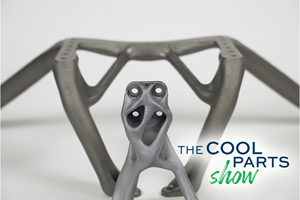Dyndrite End-User Software Expands Development for LPBF Machines
System supports multioptic build strategy operations and laser parameter control limited only by vendor openness.

Photo Credit: Dyndrite
Dyndrite has developed the company’s first end-user application focused on materials and process development for laser powder bed fusion (LPBF) machines. The software is said to give LPBF materials, part/process and applications engineers power and control over their geometry, build specific toolpathing and laser parameters, all while enabling the use of new alloys, build rate strategies and methods for printing previously unprintable parts. The software also provides native file support for a variety of LPBF machines, including Aconity, EOS, Renishaw, SLM Solutions, Trumpf and others.
“The industry previously did not have the software needed to rationally explore the opportunities provided by laser powder bed fusion processes. Users could not efficiently investigate new materials, new build strategies or even new machine architectures,” says says Steve Walton, Dyndrite head of product. “Dyndrite changes this. This new software provides a flexible new approach, a new data model, innovative and performant APIs, and complete access to toolpath geometry for those who want or need to go further.”
Dyndrite Materials and Process Development for LPBF application was designed for the needs of materials and process innovators pushing the boundaries of laser metal-based AM manufacturing. It is said to take maximum advantage of the features within the company’s Accelerated Computation Engine (ACE), including working directly with native CAD data, handling massive files, the ability to create shareable build recipes and improving print quality for various geometric features such as domes, cantilevers and thin walls.
The LPBF software takes advantage of the company’s previously announced 3D Volumetric Part Segmentation technology, which enables the detection of upskins, downskins, inskins and part features typically missed by 2.5D layer-by-layer-based solutions. Using this new geometry query method, parts, materials and machines can now be quickly qualified using geometric operations to compensate for challenges associated with process physics, the company says. Moreover, 3D volumetric segmentation means users never need to manually combine multiple build files again.
Dyndrite’s ability to save out “build recipes”' opens the door to transparent and shareable toolpathing recipes that unlock the full potential of what’s possible on LPBF machines. The company says anyone can now make a recipe and share it.
Working with CAD data directly enables seamless and automated CAD-to-print strategies that shorten print preparation, enable flexible part support strategies and speed DOE experiments.
“Dyndrite’s Toolpathing API unlocked a new dimension of flexibility for our additive manufacturing processes,” says Sam Miller, director, AM Software, AM automotive manufacturer. “The additional control over our SLM machines enables us to achieve better material performance and cost productivity in a high-quality manufacturing environment."
The Dyndrite Materials and Process Development for LPBF application is available via the company’s “Early Adopter Program” — a white-glove service offered to a limited number of customers. The LPBF software provides off-the-shelf support for leading LPBF machines, including Aconity3D, AddUp, EOS, Farsoon, Renishaw, SLM Solutions, Trumpf and others.
- Read how Dyndrite and SLM Solutions are working together to enable users to fully create SLM parameters and tool paths to fit their individual needs, maximizing materials development and application or part-specific build rate strategies.
- Learn how HP plans to use the Dyndrite Kernel to help power its next-generation, cloud- and edge-based digital manufacturing solutions.
Related Content
3D Printed "Evolved Structures" for NASA Exoplanet Balloon Mission: The Cool Parts Show #61
Generative design creates stiff, lightweight brackets for EXCITE mission monitoring planets orbiting other stars. The Cool Parts Show visits Goddard Space Flight Center.
Read MoreSemiconductors, Tungsten, AM Affordability and More from Formnext 2024: AM Radio #56
The trade show included increased applications for the semiconductor market, machine launches and technology advances aimed at cost cutting, plenty of LFAM and more. Listen to our conversation on Formnext 2024.
Read MoreRobot Vs. Gantry for Large-Format Additive Manufacturing (Includes Video)
Additive Engineering Solutions, specialist at 3D printing very large parts and tools on gantry machines, now also uses a robot for large-format AM. Here is how the robot compares.
Read More3D Printed Cutting Tool for Large Transmission Part: The Cool Parts Show Bonus
A boring tool that was once 30 kg challenged the performance of the machining center using it. The replacement tool is 11.5 kg, and more efficient as well, thanks to generative design.
Read MoreRead Next
Bike Manufacturer Uses Additive Manufacturing to Create Lighter, More Complex, Customized Parts
Titanium bike frame manufacturer Hanglun Technology mixes precision casting with 3D printing to create bikes that offer increased speed and reduced turbulence during long-distance rides, offering a smoother, faster and more efficient cycling experience.
Read MoreCrushable Lattices: The Lightweight Structures That Will Protect an Interplanetary Payload
NASA uses laser powder bed fusion plus chemical etching to create the lattice forms engineered to keep Mars rocks safe during a crash landing on Earth.
Read MorePostprocessing Steps and Costs for Metal 3D Printing
When your metal part is done 3D printing, you just pull it out of the machine and start using it, right? Not exactly.
Read More




















